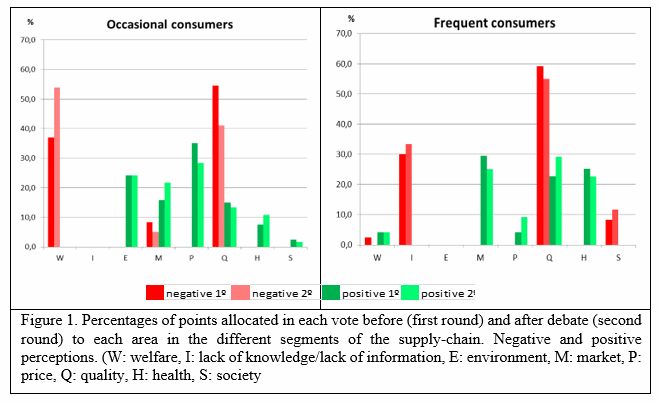CONSUMER'S POSITIVE AND NEGATIVE PERCEPTIONS TOWARDS AQUACULTURE: A HYBRID DELPHI APPROACH.
Introduction and Objectives:
Aquaculture is one of the food sectors with a higher potential for growth. The sector incorporates every time a higher level of scientific and technological advances. However, in Spain, consumers' unawareness about the production and its processes seems to play against the sector. Their perceptions towards aquaculture could become a bottleneck for the industry's full development. In this context the main objective of this paper is to explore consumers' perceptions towards aquaculture. Specifically, we determine which are the main drawbacks (prejudices) and advantages that consumers derive from the products provided by the fish farm industry. Defining these aspects will help us to develop communication strategies in order to improve aquaculture's image for the general public.
Methodology:
Methodologically, a qualitative study by means of a combined technique known as Hybrid Delphi (Landeta et al. 2011) was carried out. This method combines three qualitative techniques for group analysis: the Focus Group (FG), the Nominal Group Technique (NGT) and the Delphi method. The FG allows obtaining the less rationale and the more spontaneous information that usually is not obtained through questionnaires (Krueger & Casey, 2009). The Focus Groups were implemented introducing the NGT. This method is oriented to the generation of ideas and their ordering (ranking). Participants are asked to provide any idea they have about the positive and the negative aspects of aquaculture. All this aspects or ideas are shown in a screen. Once this is finished, and without any discussion, participants are given 15 points to allocate to their five most important ideas (5, 4, 3, 2 and 1 points from the most important to the least). Afterwards, there is a debate where all participants can argue in favour or against any of the ideas written on the screen. Later, a second round of votes is performed. All sessions are videotaped for its further transcription and analysis. Two groups of consumers (8+8) participated in this study. The groups were defined by their weekly fish consumption. Thus, there was a first group defined as frequent consumers (consumption ≥ 2 times/week), and a group defined as occasional consumers (< 2 times per week). The following stage of our research is implemented by the Delphi method (Phil, J. 1971). The Delphi questionnaire was designed after the results of the first stage of our study, which are shown on the Results section. The results from the Delphi method are still under investigation.
Results:
The group of frequent consumers prioritise as positive aspects of aquaculture a greater health control (including mercury control) with 22.5% of the points, a lower price (20.8%) and an acceptable taste (20.0%). The most voted negative aspects were the lack of knowledge and information (24.2%) and the fact that more chemical products are used to grow fish (24.2%). The group of occasional consumers prioritise as the most important positive aspect the cheaper price of the aquaculture product (24.2%). As second choices several questions received a similar number (11-13) of points: the greater health control, the popularisation of species that would not be available for consumers if there was no aquaculture and that aquaculture is friendlier to the environment when compared with the fisheries and is essential to the maintenance of some species. For this group the most negative aspects were that aquaculture is not a natural process where the fish are forced to grow quicker (18.8%) and that aquaculture products are of lower quality than fisheries products (17.1%). Comparing both rounds of votes, for each question and in each group, differences of the number of points allocated to the items were obtained. The higher difference after the debate was found in the group of occasional consumers for the non natural process of growing (10.9% to 18.8%) and the worse quality of fish from aquaculture (24.4% to 17.1%). All questions arisen were allocated to a specific thematic area, which were: W: welfare, I: lack of knowledge/lack of information, E: environment, M: market, P: price, Q: quality, H: health, S: society (figure 1). Quality issues are important for consumers, mainly the negative ones, being market and price the most positive aspects of aquaculture. Negative aspects of welfare are only important for occasional consumers. The most striking result is that environment is not a concern for any of the groups (no present in frequent consumers and considered only as a positive aspect by the group of occasional consumers)
Conclusions:
The perception of aquaculture by consumers is not completely positive or negative, but depending on the aspect considered. Environment is not a concern for both groups of consumers, contrarily it's seen as positive. In the negative side, Quality aspects are the most important concern for consumers, as well as Welfare in the occasional consumers. A societal lack of knowledge and need of information on aquaculture subjects is pointed out by the group of frequent consumers. The group debate changed some of the consumers' perceptions, therefore, we can conclude that the provision of information based on scientific data, if given in a friendly format, would be a good step to improve aquaculture's image for the general public.
References:
Krueger, R.A. y Casey, M.A. (2009). Focups groups: A practical guide for applied research (4th edition). Thousand oaks, CA: Sage Publications.
Landeta J., Barrutia J. y Lertxundi A. (2011). Technological Forecasting and Social Change, Volume 78 (9).Pages. 1629-1641.
Pill J. (1971). Socio-Economic Planning Sciences, Volume 5, Issue 1, February 1971, Pages 57-71, ISSN 0038-0121, http://dx.doi.org/10.1016/0038-0121(71)90041-3.
